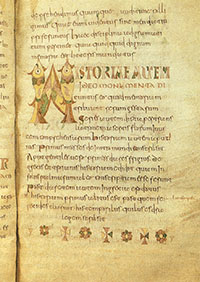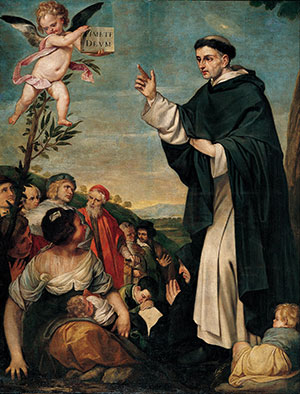St. Isidore is the patron saint of the Internet and the author of the first encyclopedia ever written, called "Etymologiae." In 20 volumes, St. Isidore compiled all of the learning of his day. Throughout the greater part of the Middle Ages and the Renaissance, it was the textbook most used in schools.
St. Isidore was born in Cartagena, Spain, around the year 560 and succeeded his older brother as the archbishop of Seville. He was a prolific writer on the Scriptures and theology, as well as on the knowledge of his day in the fields of physics, astronomy, history and geography. He also wrote a dictionary of synonyms.
During his episcopate, the classic learning institutions of the Roman Empire were being destroyed by the barbarous Goths, who were in power in Spain. In an effort to counter this, St. Isidore encouraged education and the study of law, medicine and the liberal arts. He eradicated Arianism and other heresies and reinforced religious discipline.
At the Second Council of Seville, begun Nov. 13, 619, St. Isidore persuaded all bishops to establish seminaries in cathedral cities, making education an obligation for all bishops.
 Detail of a page from St. Isidore’s “Etymologiae,” a Carolingian manuscript dating from the eighth century, at the Royal Library of BelgiuHe also had great admiration for monks and wrote a book called "Regula monachorum" on the monastic life, though he wasn't a monk himself. In it, he said religious life is proof of true Christian democracy by admitting men of every rank and station of life.
Detail of a page from St. Isidore’s “Etymologiae,” a Carolingian manuscript dating from the eighth century, at the Royal Library of BelgiuHe also had great admiration for monks and wrote a book called "Regula monachorum" on the monastic life, though he wasn't a monk himself. In it, he said religious life is proof of true Christian democracy by admitting men of every rank and station of life.
"God has made no difference between the soul of the slave and that of the freedman," he wrote. In the monastery, he said, all are equal in the sight of God and of the Church.
St. Isidore was the last of the ancient Christian philosophers and great Latin Fathers. He died April 4, 636, and his feast is celebrated each April 4.
— Source: Catholic News Agency
What is a Doctor of the Church?
Doctors of the Church are great saints known for their defense and explanation of the truths of the Catholic faith. The original eight Doctors of the Church were named by acclamation, or common acknowledgment. The rest have been named by various popes, starting with the addition of St. Thomas Aquinas to the list by St. Pius V in 1568.
The title “Doctor of the Church” indicates that the writings and preachings of such a person are useful to Christians “in any age of the Church.” Such men and women are particularly known for the depth of understanding and the orthodoxy of their theological teachings. Through their research, study and writing, they have advanced the Church’s knowledge of our faith.
While the writings of the Doctors are often considered inspired by the Holy Spirit, this does not mean they are infallible. It does mean that they contributed significantly to the formulation of Christian teaching in at least one area, and that their work overall serves to advance the cause of Christ and His Church.
The title was first given in the Middle Ages. Originally, there were four great Doctors of the Church: St. Ambrose, a fourth-century bishop of Milan; St. Augustine, a fifth-century bishop of Hippo; St. Gregory the Great, who was pope at the start of the seventh century; and St. Jerome, the fifth-century biblical scholar and translator.
Today, there are 37 Doctors of the Church: 28 from the West and nine from the East.
— USCCB
Read more about the Doctors of the Church
Feast day: April 5
 Roman Catholics celebrate the missionary efforts of St. Vincent Ferrer on April 5. The Dominican preacher brought thousands of Europeans into the Catholic Church during a period of political and spiritual polarization in Western Europe.
Roman Catholics celebrate the missionary efforts of St. Vincent Ferrer on April 5. The Dominican preacher brought thousands of Europeans into the Catholic Church during a period of political and spiritual polarization in Western Europe.
Vincent Ferrer was born in Valencia, Spain, during 1357. His parents raised him to care deeply about his religious duties, without neglecting his education or concern for the poor. One of his siblings, Boniface, later joined the Carthusian order and became its superior general. Vincent, however, would become a Dominican and preach the Gospel throughout Europe. He joined at age 18 in 1374.
As a member of the Dominican Order of Preachers, Vincent committed much of the Bible to memory while also studying the Church Fathers and philosophy. By age 28, he was renowned for his preaching, and also known to have a gift of prophecy. Five years later, a representative of Pope Clement VII chose Vincent to accompany him to France, where he preached extensively.
While Vincent sought to live out his order’s commitment to the preaching of the Gospel, he could not escape becoming involved in the political intrigues of the day. Two rival claimants to the papacy emerged during the late 1300s, one in Rome and another in the French city of Avignon. Each claimed the allegiance of roughly half of Western Europe, in what was called the “Western Schism.”
Caught between the rival claimants, Vincent attempted to persuade the Avignon Pope Benedict XIII to negotiate an end to the schism. Benedict, who was regarded as pope in both Spain and France, sought to honor Vincent by consecrating him as a bishop. But the Dominican friar had no interest in advancing within the Church, and regarded many bishops of his time as negligent leaders distracted by luxury.
“I blush and tremble,” he wrote in a letter, “when I consider the terrible judgment impending on ecclesiastical superiors who live at their ease in rich palaces, while so many souls redeemed by the Blood of Christ are perishing. I pray without ceasing, to the Lord of the harvest, that He send good workmen into His harvest.”
Vincent not only prayed, but acted – committing himself to missionary work and resolving to preach in every town between Avignon and his hometown in Spain. In a commanding style, he denounced greed, blasphemy, sexual immorality and popular disregard for the truths of faith. His sermons often drew crowds of thousands and prompted dramatic conversions.
Popular acclaim, however, did not distract him from a life of asceticism and poverty. He abstained completely from meat, slept on a straw mat, consumed only bread and water on Wednesdays and Fridays, and accepted no donations for himself beyond what he needed to survive. He traveled with five other Dominican friars at all times, and the men would spend hours hearing confessions.
For two decades, Vincent and his group of friars undertook preaching missions in Spain, Italy and France. When he traveled outside these regions, into Germany and other parts of the Mediterranean, those who did not know the languages in which he preached would testify that they had understood every word he said, in the same manner as the apostles experienced at Pentecost.
Although he did not heal the temporary divisions within the Church, Vincent succeeded in strengthening large numbers of Europeans in their Catholic faith. He wrote little, although some of his works have survived, and exist in modern English translations.
According to the Catholic Encyclopedia, “Vincent felt that he was the messenger of penance sent to prepare men for the judgment. For 20 years he traversed Western Europe preaching penance and awakening the dormant consciences of sinners by his wondrous eloquence. His austere life was but the living expression of his doctrine.”
St. Vincent Ferrer died on April 5, 1419, at age 62, in the city of Vannes in the French region of Brittany. He was canonized in 1455, and has more recently become the namesake of a traditional Catholic community approved by the Holy See, the Fraternity of Saint Vincent Ferrer.
He is considered a patron saint of reconciliation, as well as the patron of builders, construction workers, plumbers and fishermen.
— EWTN/Catholic News Agency
What was the Western Schism?
The Western Schism, also called Papal Schism, Great Occidental Schism and Schism of 1378, was a split within the Catholic Church lasting from 1378 to 1417 in which two – and since 1410 even three – men simultaneously claimed to be the true pope, having excommunicated one another. Driven by politics rather than any theological disagreement, the schism was ended by the Council of Constance (1414-1418). For a time these rival claims to the papal throne damaged the reputation of the office.
The affair is sometimes referred to as the Great Schism, although this term is typically reserved for the more enduring East-West Schism of 1054 between the Western Churches answering to the See of Rome and the Orthodox Churches of the East.
— Wikipedia
More online
At www.greatschism.org: Read more about the Western Schism, its causes and impacts on the Church

